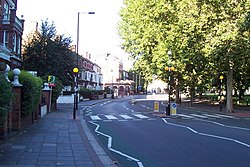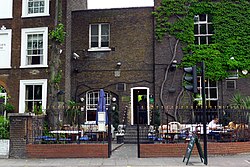Parsons Green
| Parsons Green | |
| Middlesex | |
|---|---|
 Parsons Green, along the New King's Road | |
| Location | |
| Grid reference: | TQ251765 |
| Location: | 51°28’26"N, 0°11’57"W |
| Data | |
| Population: | 10,813 (2011) |
| Post town: | London |
| Postcode: | SW6 |
| Dialling code: | 020 |
| Local Government | |
| Council: | Hammersmith and Fulham |
| Parliamentary constituency: |
Hammersmith Chelsea and Fulham |
Parsons Green is a mainly residential district of Middlesex attached to Fulham, deep in the metropolitan conurbation. It straddles the King's Road, the A308 road and Parsons Green Lane, bounded by the Harwood and Wandsworth Bridge Roads, the A217 road to the east and Munster Road to the west, while the Fulham Road may be said to define its northern boundary
At its historic centre lie two open spaces, the Green itself and Eel Brook Common. The name stems from the original village green, after the former residence of the rectors of Fulham Parish.[1] Much of Parson's Green has been declared a conservation area.
History


Timber rights attached to the Green are mentioned in court rolls dating from 1391. In 1625 there were only six rated residents for the area. By 1706, John Bowack opined in his Antiquities of Middlesex that it "was inhabited mostly by gentry and persons of quality".[2]
Two cricket matches with important status were held on Parsons Green in 1731 and 1733. The first was on Tuesday, 10 August 1731 between Fulham Cricket Club and Chelsea Cricket Club, Fulham winning.[3] The second was on Tuesday, 26 June 1733 between the same two teams and played for a substantial prize of 30 guineas, although the result is unknown.[4]
In the 18th century, changes continued with the building of grand houses with grounds. These were bought by merchants and bankers from the City and not infrequently by members of the Court and their 'associations'. The area acquired a somewhat louche reputation at that time.[5]
Fulham F.C. had their ground in the park for two years from 1889. Early in the 20th century, a few test flights were carried out there with flying machines.
Houses of note
- Holly Bush House - later 'East End', tenancy of Maria Fitzherbert, demolished 1884
- Belfield House - home of Mrs Jordan, later part of Lady Margaret School
- Elm House - also became part of Lady Margaret School
- Henniker, later Park House, designed by Thomas Cubitt, demolished 1889
- Aragon House
- Gosford Lodge
- Pitts Place terrace, including, Albyn, Belgrave, Cardley and Sefton
Outside links
| ("Wikimedia Commons" has material about Parsons Green) |
- Eel Brook Common: London Gardens Online.
References
- ↑ "Parsons Green, Hammersmith & Fulham". http://hidden-london.com/gazetteer/parsons-green/.
- ↑ Denny, Barbara: 'Fulham Past' (London: Historical Publications, 1997) pages 45–8 ISBN 0 948667 43 5
- ↑ Waghorn, p. 9.
- ↑ Buckley, p. 8.
- ↑ Féret, Charles (1900) (PDF). Fulham Old and New, vol.I-III. III. Leadenhall Press. https://ia802205.us.archive.org/30/items/fulhamoldandnew00frgoog/fulhamoldandnew00frgoog.pdf.
- Buckley, G. B.: 'Fresh Light on 18th Century Cricket' (Cotterell, 1935)
- Waghorn, H. T.: 'The Dawn of Cricket' (Electric Press, 1906)
